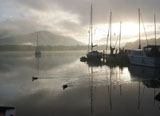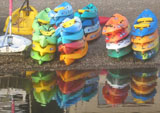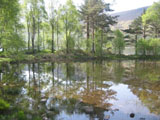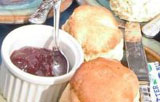|
|
Lake District Valley and
Low-level Walks
Walks around Ambleside
Click here for more walks around Ambleside
The Troutbeck Round
Total feet of climbing 600;
3.25 miles; 1.5 hours
Troutbeck is one of the more interesting and appealing villages in the
Lake District. It has an unusual situation and layout strung along the
western slopes of the valley it occupies giving every house a commanding
view of the dale. This walk follows a route round the spur of fell-land
that rises above the village mostly by way of enclosed trackways. On the
outward journey there are views of lake Windermere. But the best views are
perhaps those obtained on reaching the highest part of the walk when there
comes in to view the even higher peaks of Ill Bell and Froswick.
Beginning from the Mortal Man Inn, walk in a southerly direction on the
main road through the village. On reaching the village post office, sited
in the ground floor of the village institute, bear right past the village
institute's flag pole on to a signposted public bridleway: Robin Lane.
(0.5 mile)
After three quarters of a mile the lane becomes gated. At this point
branching off to the left through another gateway is a signposted
bridleway to Skelghyll. Ignore this bridleway and continue on the lane
which now becomes Hundreds Road. Passing through a final gate the trackway
becomes unenclosed and loops round to the left over a small stone bridge.
(1.5 miles)
Just before crossing the
bridge leading off to the right is a signposted path to Wansfell and Nanny
Lane. The path is waymarked with small wooden posts on which are fixed
round signs bearing a white arrow. The path eventually links up to a much
broader path leading down from the top of Wansfell at a point where it
passes through a metal gate. Here turn right and follow the more prominent
path downhill. Within a few hundred yards the path joins an enclosed
trackway: Nanny Lane. (0.5 mile)
Here turn right and follow Nanny Lane downhill to Troutbeck. On reaching
the roadway turn left. The Mortal Man is a hundred and fifty yards further
on. (0.75 mile)
The Mortal Man
This inn was originally called the White House but around 1800 a local
painter and patron of the inn called Julius Caesar Ibbetson painted a new
sign for it. It depicted the portraits of two of his neighbours, one was a
jolly fat fellow, called Nat Fleming; the other long, lean and pale, was
called Ned Partridge. Beneath them was written this rhyming dialogue:
Oh Mortal Man that lives by bread
What is it makes thy nose so red?
Thou silly fool that looks so pale,
T'is drinking Sally Birkett's ale.
The sign was such a success the inn was soon known as the Mortal Man. The
original sign, however, was retained by the landlord of the inn when he
retired and has since been lost. The present sign is a recreation.
Rydal Caves and Rydal Park
4 miles [6.5 km]
This walk gives the best views over Rydal Water and takes you to the
man-made caves of Loughrigg Quarry. Wordsworth enthusiasts can visit Rydal
Mount, the home of the poet for thirty-seven years. The walk has the merit
that, with luck, one can arrive back with reasonably dry footwear.
Park the car on one of the Ambleside car parks. Walk on along main road
towards Grasmere and Keswick. The curious Bridge House is passed. Its
origin is something of a mystery but one theory is that it was built by
someone to avoid paying land rent. Cross over to right hand side of road.
When the pavement ends at a drive entrance cross the road again with great
care. After half a mile the cricket field is on the left, and after this
there is a wood above the road level. At the end of this wood there is a
gate into a field. Go through the gate.
There is no apparent path in the field, but slightly to right of front,
beyond a slight knoll, is a group of trees. Head for the right of these.
There is only a right of way across the field. Continue past the
trees on the same line and the river will be reached and the stepping
stones. Cross these with care to join road at the other side. Turn right.
Go through the gate by the cattle grid and continue along the road to
another gate and cattle grid. Turn left down the lane through another.
Follow this lane until an iron gate is reached which leads onto fell land
and distinct tracks. Take the upper track, and at the seat there is a
perfect view over Rydal Water. The crags across the lake are Nab Scar. The
cottage at the foot was the home of Hartley Coleridge, son of Samuel
Taylor Coleridge and friend of the Wordsworths.
Follow the track up, through woodland. After a bend right a conical crag
will be seen and Loughrigg Quarry has been reached. If you go to the left
of this crag the smallest cave will be seen across a gully. Go back onto
the track and continue up, zig-zagging left then right through some
attractive larch trees. The big cave can then be seen and entered.
The platform of waste opposite the cave entrance is a natural rock garden.
Although there is little soil here, if the land was not grazed by sheep it
would soon be colonised by the larches, silver birch and ash trees which
can all take root in the quarry waste. Where sheep cannot reach seeds will
germinate.
Follow the track back to the view-point scat, then descend towards lake
and a kissing-gate will be seen in the wall on the right. Go through this
into the wood. Follow it to a footbridge. This brings us onto the main
road again. Cross it. Turn right towards Ambleside but go
left up the nearby access road. Rydal Chapel is on the left. Wordsworth
helped to choose the site where
it was built and worshipped here regularly. If it is daffodil season then
go through the chapel yard to Dora's Field beyond, to see a golden
carpet.
Go on up the road. Some old cottages can be seen on the left. Just above
them is Rydal Mount which is now open to the public. Our way from here
is on the right. Just above the entrance drive to Rydal Hall, which is a
conference centre and not open to the public, there is another entrance
onto a lane. Follow this through the yards of the buildings, turning right
at the end after crossing the bridge, then bearing left at the Y junction.
This is Rydal Park. It is the private park of Rydal Hall and there is no
access off the lane but we can enjoy the walk along this pleasant lane
none the less. There are some fine trees and the well cared-for fields can
be an unbelievably bright green. They are the scene of the well known
Rydal Sheep Dog Trials.
The main road is joined again through some tall iron gates. Cross the road
to the pavement on the far side. Continue left to
Ambleside, about a third of a mile.
Ambleside and waterfalls
A circular walk of 2 to 2.5 hours through
woodlands, the byways of old Ambleside, waterfalls, riverbanks and lake
shore.
From the piers at Waterhead cross the main A591 road by the corner of the
Waterhead Hotel and take the public footpath marked to Jenkins Crag. The
path is rough and quite steep at first, then it levels out and crosses a
field into woodland. Follow it up into the woods for just over 100 metres
and look carefully for the turning left, it is not too obvious at first,
but after a short distance the path soon becomes clear and as it leaves
Skelghyll Woods it joins a rough track. Go left and admire the view across
the lake head and the ancient Roman Fort of Galava. The track soon meets a
surfaced roadway, carry straight on down towards the village and you will
see the garden centre below.
The first road you come to is the Old Lake Road and you turn right onto it
(the main road runs parallel to it but we wish to avoid that),. Follow the
road past the car park on your left, past Fisherbeck Lane and then Blue
Hill Road on your right, then take the next right turn up Low Gale Road
(marked "No Through Road"). After 150 metres, ignore the path down to the
village and follow the sign for Stockghyll and Warisfell which points up
the road 'Gale Howe Park'. In another 50 metres you will see the footpath
going left. Follow this path until you come out onto a driveway "Havenwood"
and carry on left between high beech hedges until you come to the road
then turn left. You should by now be aware of the sound of rushing water
and as you walk down the road you will catch your first sight of the
waterfalls to the right. The entrance to Stock Ghyll Park is only 200
metres away.
The walk through the woods is a delight at
any time of year. Birds, flowers, squirrels, tumbling waters all within a
few hundred yards of one of Lakeland's busiest villages. Whenever the path
forks keep to the higher levels on the right and walk to the top of the
falls. A wooden foot-bridge crosses the river here and the path brings you
back down the other side. The full circuit need only take thirty minutes
but this is not a walk to hurry and there are many viewpoints and resting
places.
When you are ready to leave, join the road again and continue down until
you come to the main road in the village. You may go left through the
village centre, and the main road will bring you back to Waterhead and the
piers. However if you want to avoid the village turn right on the main
road, walk past the market cross and the shopping precinct, (the Bridge
House is approximately 100 metres further along the main road), and turn
down Compston Road for 50 metres and follow sign right for Rothay Park and
Loughrigg. Walk on past St. Mary's Church and through the park until you
come to the river.
Do not cross the bridge but follow the path
left alongside the riverbank. When you reach the end of the park cross
over a wooden stile and continue until you come to the road. Tum right
down the access road and right again onto the main road, walking against
the one way traffic system pass Riverside Lodge Country Hotel on the right
and Rothay Manor Hotel on the left. Do not cross the bridge on the right
but walk round Rothay Manor and after 50 metres tum right onto a public
footpath. Again do not cross the bridge but enter the field by the gate
alongside and walk to the riverbank. Follow the river downstream through
two fields and carry on alongside the riverbank eventually coming to a
wooden boardwalk over the worst of the muddy ground ' Enter the field and
walk past the remains of Galava, the Roman Fort, to an iron kissing gate
to enter Borrans Park. Follow the path towards the lake and you will soon
be able to see across to the piers at Waterhead and watch for your boat
coming in to take you back to Bowness or Lakeside.
Stang End and Low Oxen Fell
3 miles [5 km]. This is a short walk which can fill in
a very pleasant hour or more. It is routed most of the way over
hard-surfaced tracks and one has a very reasonable chance of returning
dry-shod. The walk starts at a lane junction with the Ambleside to
Coniston road. From Ambleside take the Coniston junction at Skelwith
Bridge and continue for about 1.75 miles. The lane is on the right at the
top of the hill, and is the one after the road which is signposted
'Wrynose Pass, Elterwater, Little Langdale'. At the time of writing this
lane is merely signposted 'Unfit for Cars'. Turning in at this lane there
is immediately a grass area on the left with space for parking. From
Coniston the lane is about four miles along the Ambleside road, beyond the
hill crest and beginning the descent.
Having parked, take the right-hand road. A plantation of spruce and larch
and Scots Pine is on the right. Shortly the bulk of Wetherlam can be seen
on the left. Then there is a craggy outcrop in the field on the left, and
through the gap can be seen Lingmoor. The protuberance is Busk Pike. There
are soon some handsome Scots Pines, right. The crag on the left is Little
Fell. The road begins to fall and the view of the fells open up, towards
the north. The mountain on the left is the Helvellyn range; then there is
the gap of Grisedale Hause; then the Fairfield range with the highest
point at the rear, and the peaks of Greatrigg, and Heron Pike before; to
the right of that is the valley head of Rydal, then the peaks of Hart Crag
and Dove Crag; the nearest and lower fell is Loughrigg, with Elterwater
below it. As you turn a corner, go through the gate, and there is a view
of the lower part of Little Langdale. The buildings of High Park, typical
old dwellings in the care of the National Trust, are now approached.
Continue along the road and the buildings of Stang End are reached. At
Stang End turn left and up the hill past the barn where the road surface
changes to stone.
The road winds and climbs between birch woods. The views to the right are
of Pike o'Blisco; behind is Crinkle Crags; and to the right the impressive
hump of Bowfell. The quarries of Moss Rigg are seen. The tree-clothed crag
on the left makes a pretty picture. Go through a gate and continue on the
stony track, which changes to macadam as it goes through mixed woodlands.
Ignore branch road to the right. Some quarry buildings are approached. The
old quarry heaps have been taken over by silver birch trees which are
self-seeded. They are invariably the first trees to colonise the sparse
pockets of soil, their leaf mould later giving other species an
opportunity to join them. There are cottages on the right. This is Hodge
Close. Very shortly after this there is a very sharp turning to the left,
a stone track, with a slate supporting wall on its right containing the
quarry waste from above. Take this track. At the top of the first rise
there is a little reedy pool on the left. The track rises and falls, then
passes through a gate.
You are now on a piece of fell land among juniper bushes. The berries of
the juniper have long been used as a valuable herb for kidney ailments but
are more commonly known for flavouring gin. The green berries have the
sharp gin taste, the ripe black berries are too sweet and sickly. The
bush, looking like a cross between gorse and a miniature yew tree, is
common on the Lake District fells. It is our only native member of the
cypress family, and is getting scarcer in some parts of Britain. The track
zig-zags, then culverts a beck, then goes through the farmyard of High
Oxen Fell, where the surface changes again to macadam. It rises and there
are fine views to the left. At the fork bear left. The road falls to Low
Oxen Fell Falls, to cross a beck, then rises slightly and you are soon
back at the crossroads where the car is parked.
Jenkyn Crag and Skelghyll
3 miles [5 km]
Jenkyn Crag is one of the best viewpoints for the head of Windermere Lake.
It can be reached by anyone, and a visit to it can be combined with an
interesting round walk through SkeIghyll woods.
Park your car at Waterhead Car Park, or the neighbouring public car park
by the Regent Hotel. Both are at the head of the lake about 0.75 mile
south of Ambleside. Leave the car park towards the lake and walk left
towards the pier; however, before reaching it turn left alongside the end
of the Waterhead Hotel. If you stand here and look across the main
Ambleside to Windermere road, you will see a gap in the wall, with steps,
between the Romney Hotel on the right and the Ghyll Head Hotel left. This
is the route.
The path climbs between fences, on loose stones, and turns right when it
reaches a wall. Soon the path ends at a step stile over the wall on the
left. Go through this and cross the field. This is a farm field and not a
public access area; there is a right of way across it only. The wall just
ahead bends left, then right, and there is a stile near the corner similar
to the last. Through this stile and you are in a National Trust woodland
and you can wander at will; but our path is the one that bears right from
the stile. It crosses a slate bridge and climbs through the wood - a
hardwood mixture largely, of ash, oak, silver birch and alder. There are
also a number of geans, or wild cherries in this wood. In Spring, white flowers and pink buds identify
them; in Autumn their leaves
from yellow, through orange, to red. The leaves are long with serrated
edges, their bark similar to the silver birches, but reddish.
Continue up to a T junction by an iron seat. (A few yards before this a path
appears to cross the one you are on; ignore it.) Turn right along a very
distinct track. There are now some conifers in the wood. The track turns left by a
ghyll
and ascends by rough crag steps.
A bridge is soon approached. Cross, and ignore the track left. There are
now now two tracks. The right-hand one is better after wet weather. The
left-hand one has a gentler climb but is inclined to muddiness. The track presently falls, and then levels; then look for a
wall
gap to the right, with a path leading from it to a crag. There should be
a National Trust sign at this point. Walk through and up to the crag
through the trees, and you are on Jenkyn Crag. Take care how you walk if
the rock is wet.
There is a good view of Windermere head from here as far down the lake as
Belle Isle and Bowness. The tarn on the hillside opposite is Blelham Tarn,
to the left of it is the cairned fell of Latterbarrow, and left again the
woods of Claife Heights. The Coniston old Man range is ahead in the
background. To the right of this range is Wrynose Pass then Crinkle Crags,
Pike o'Blisco, Bowfell, and to the right of that the Langdale Pikes. In
front of this, and commanding the head of the lake, is Loughrigg Fell. To
the left of Blelham Tarn, and below it, is Wray Castle, a fine example of
the Victorian romantic era.
When you have lingered and enjoyed this view, leave the crag by the way
you came, but on reaching the track turn right and ascend slightly.
Presently the wood finishes on the right, and there is a view of the lake
across open fields. The large hardwood which you should now see is a
typical cherry. A little
farther on you may well wonder at the two iron wicket gates, well
maintained and locked, to right and left. Another such gate will be
noticed down the field, right, and another in the wall next to it. This
marks the way of the water pipeline from Thirlmere reservoir to
Manchester.
Beyond the gate there are again good views across to the lake. Go through
two gates, through the farm-yard High SkeIghyll and down the track. Go
through another gate, and instead of turning left to cross the bridge over
the ghyll, bear right along the track. Go through another gate and the
track bends right away from the ghyll, towards the lake. This is a very
pleasant walk through the fields but keep to the path as you are no longer
on a public access area. The track bends left with a wall. A little
farther on the track again bends left with the wall, but at this point we
leave the track to descend to a less clearly seen footpath towards the Low
Wood Hotel which can be seen below. Just before the bend of the wall go
through the gate on the right. The path follows a wall on the left, which
presently has a crook in it, and there is a gate. Go through gate and go
down towards the roofs of the hotel on an indistinct path. The path goes
towards a wall, bends right to follow it, and then reaches the wall at a
wooden ladder stile. Cross it. The path follows the wall down again, and
as you descend a gate will be noticed in the wall ahead, to the left.
Cross the corner of the field to it.
Through the gate follow the wall down, turn right through the gate in it,
then left through gate into the Low Wood Hotel car park. Cross between the
Low Wood buildings. Cross the road to the far sidewalk. Turn right. The
walk along the side of the lake would be pleasant but for the noise of the
traffic on the road. You can get a little further from it by crossing the
wall on the left just before the iron gate and walking along the lake
shore. The way is soon criss-crossed by roots, and depending upon the
height of the water, sooner or later you will be forced back onto the
footpath by the road-side. Following this, the wood on the left ends and
there is a green field down to the lake shore. This is in the care of the
National Trust so you can make a pleasant detour here along the side of
the water. There is a stile in the corner directly you come to the field.
Go over it and along the lake shore. From the crag there is a good view across the Langdales.
After the boathouse, ford or jump the stream and continue along the path
towards the garage. If the stream is uncrossable, follow it up to the
wall. The path turns up by the grange and through a stile onto the
roadside footpath again. Follow the footpath on, and round left to
Waterhead.
|
 |



